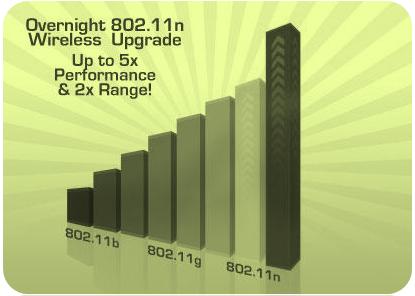The Future of Wi-Fi and 802.11n
 Which of the popular WiFi networking standards is right for you? Home and business networkers looking to buy wireless local area network usually need to face an array of choices. Many products conform to the 802.11 a,b,g,n wireless standards collectively known as Wi-Fi technologies.
Which of the popular WiFi networking standards is right for you? Home and business networkers looking to buy wireless local area network usually need to face an array of choices. Many products conform to the 802.11 a,b,g,n wireless standards collectively known as Wi-Fi technologies.
802.11 refers to a family of specifications developed by the IEEE in 1997 for WLAN technology. The original 802.11 only supported a maximum network bandwidth of 2 Mbps - too slow for most applications. For this reason, ordinary 802.11 wireless products are no longer manufactured and IEEE expanded on the original 802.11 standard to newer versions. The most popular are those defined by the 802.11b and 802.11g protocols, and are amendments to the original standard.
802.11b supports bandwidth up to 11 Mbps, comparable to traditional Ethernet. It uses the same unregulated radio signaling frequency (2.4 GHz) as the original 802.11 standard. Vendors often prefer using these frequencies to lower their production costs.
While 802.11b was in development, IEEE created a second extension to the original 802.11 standard called 802.11a. Because the standard “b” gained in popularity much faster than the version “a” did, some people believe that 802.11a was created after 802.11b, but in fact, they were created at the same time. Due to its higher cost, “a” network is usually found on business networks whereas the “b” better serves the home market. 802.11a supports bandwidth up to 54 Mbps and signals in a regulated frequency spectrum around 5 GHz. This higher frequency compared to “b” version shortens the range of 802.11a networks.
In 2002 and 2003, WLAN products start supporting a newer standard called 802.11g emerged on the market. 802.11g attempts to combine the best of the standards “a” and “b”, supporting bandwidth up to 54 Mbps, and using the 2.4 Ghz frequency for greater range. It is backwards compatible with 802.11b, meaning that the “g” access points will work with “b” wireless network adapters and vice versa.
802.11b and 802.11g use the 2.4 GHz ISM band, operating in the United States under Part 15 of the US Federal Communications Commission Rules and Regulations. Because of this choice of frequency band, 802.11b and g equipment may occasionally suffer interference from microwave ovens and cordless telephones. However, by installing the devices at a reasonable distance from other appliances, interference can easily be avoided.
The newest IEEE standard in the Wi-Fi category is 802.11n. It was designed to improve on 802.11g in the amount of bandwidth supported by utilizing multiple wireless signals and antennas (called MIMO technology) instead of one. 802.11n connections should support data rates of over 100 Mbps and also offers somewhat better range over earlier Wi-Fi standards due to its increased signal intensity. 802.11n equipment is backward compatible with 802.11g devices.
On the track of these ideas, ABP is glad to announce the launching of Altai world’s 1st outdoor industrial grade 802.11n Smart WiFi product, supporting 802.11 a/b/g/n wireless modes with dual-band built-in antennas and external antenna option. Amazingly the product supports multiple operating modes as Access Point, Repeater, CPE or Bridge mode and it offers multiple backhaul options: external 3G/WiMAX backhaul, Gigabit/100/10 Ethernet or 2.4G/5GHz WiFi. Additionally, unlike other 802.11n WiFi products available in the market, the A3 Smart WiFi has built-in access control features to provide user authentication, bandwidth management control and radius support.
The ABP Team
Feb, 2009






